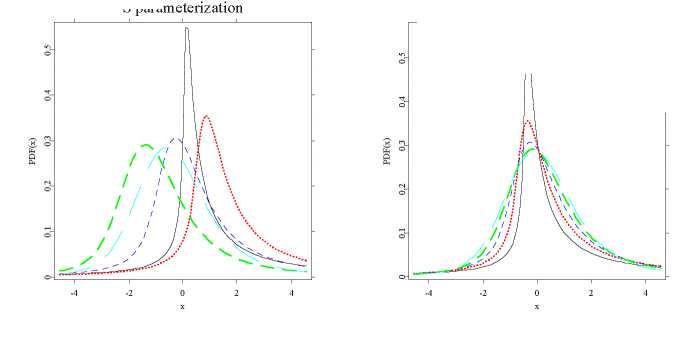1 Stable distributions
S0 parameterization

S parameterization
Figure 1.3: Comparison of S and S0 parameterizations: α-stable pdfs for β =
0.5 and α = 0.5 (black solid line), 0.75 (red dotted line), 1 (blue
short-dashed line), 1.25 (green dashed line) and 1.5 (cyan long-
dashed line).
θ STFstab03.xpl
1.3.2 Stable density and distribution functions
The lack of closed form formulas for most stable densities and distribution
functions has negative consequences. For example, during maximum likeli-
hood estimation computationally burdensome numerical approximations have
to be used. There generally are two approaches to this problem. Either the
fast Fourier transform (FFT) has to be applied to the characteristic function
(Mittnik, Doganoglu, and Chenyao, 1999) or direct numerical integration has
to be utilized (Nolan, 1997, 1999).
For data points falling between the equally spaced FFT grid nodes an inter-
polation technique has to be used. Taking a larger number of grid points in-
creases accuracy, however, at the expense of higher computational burden. The
FFT based approach is faster for large samples, whereas the direct integration
method favors small data sets since it can be computed at any arbitrarily cho-
sen point. Mittnik, Doganoglu, and Chenyao (1999) report that for N = 213
the FFT based method is faster for samples exceeding 100 observations and
More intriguing information
1. PEER-REVIEWED FINAL EDITED VERSION OF ARTICLE PRIOR TO PUBLICATION2. Declining Discount Rates: Evidence from the UK
3. News Not Noise: Socially Aware Information Filtering
4. Contribution of Economics to Design of Sustainable Cattle Breeding Programs in Eastern Africa: A Choice Experiment Approach
5. Ex post analysis of the regional impacts of major infrastructure: the Channel Tunnel 10 years on.
6. Orientation discrimination in WS 2
7. EXECUTIVE SUMMARIES
8. The name is absent
9. Magnetic Resonance Imaging in patients with ICDs and Pacemakers
10. The name is absent